Physical Address
304 North Cardinal St.
Dorchester Center, MA 02124
Physical Address
304 North Cardinal St.
Dorchester Center, MA 02124
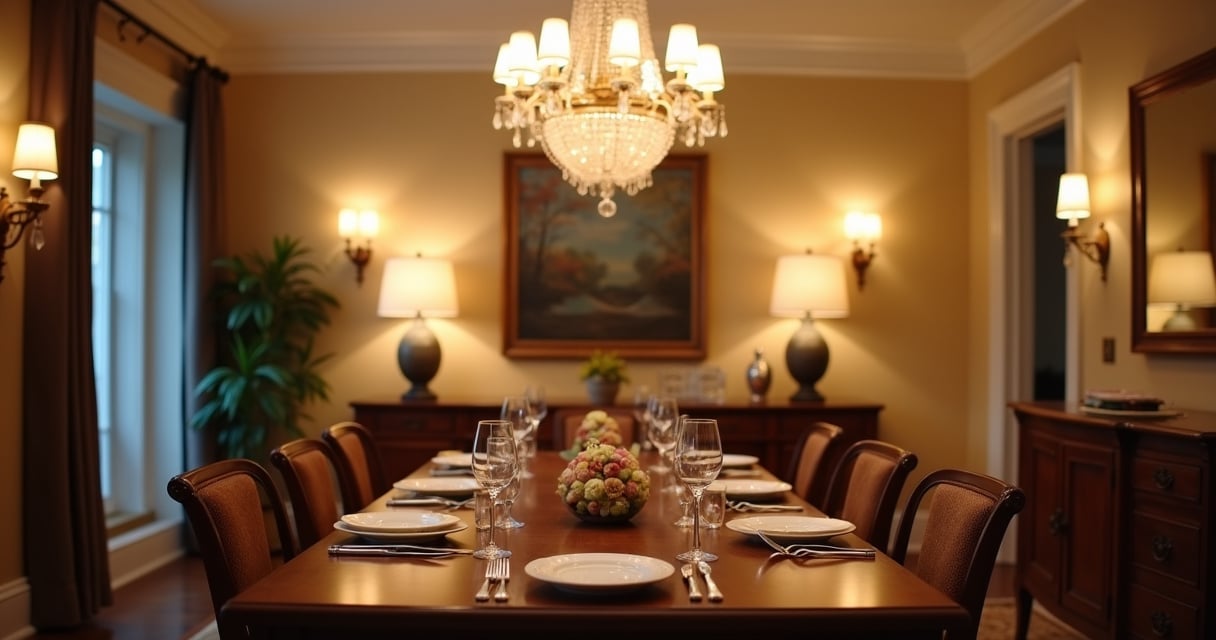
Is your dining room feeling a little…blah? It’s the heart of the home, a place for family gatherings, celebratory feasts, and cozy weeknight dinners. But often, the dining room gets overlooked, becoming a purely functional space rather than a welcoming haven.
Fear not! Transforming your dining room into a stylish and inviting space doesn’t require a complete overhaul. With a few clever design tweaks and thoughtful additions, you can create a dining room that you’ll be excited to show off and spend time in.
Ready to revolutionize your dining experience? Let’s dive into 19 transformative design ideas that will breathe new life into your dining room.
Imagine stepping into a room bathed in sunlight. Instantly, the atmosphere lifts, colors become more vibrant, and everything feels fresh and inviting. That’s the power of natural light. It’s not just about illumination; it’s about well-being. Sunlight boosts serotonin, creating a happier and more relaxed dining atmosphere. Food even looks more appetizing under natural light!
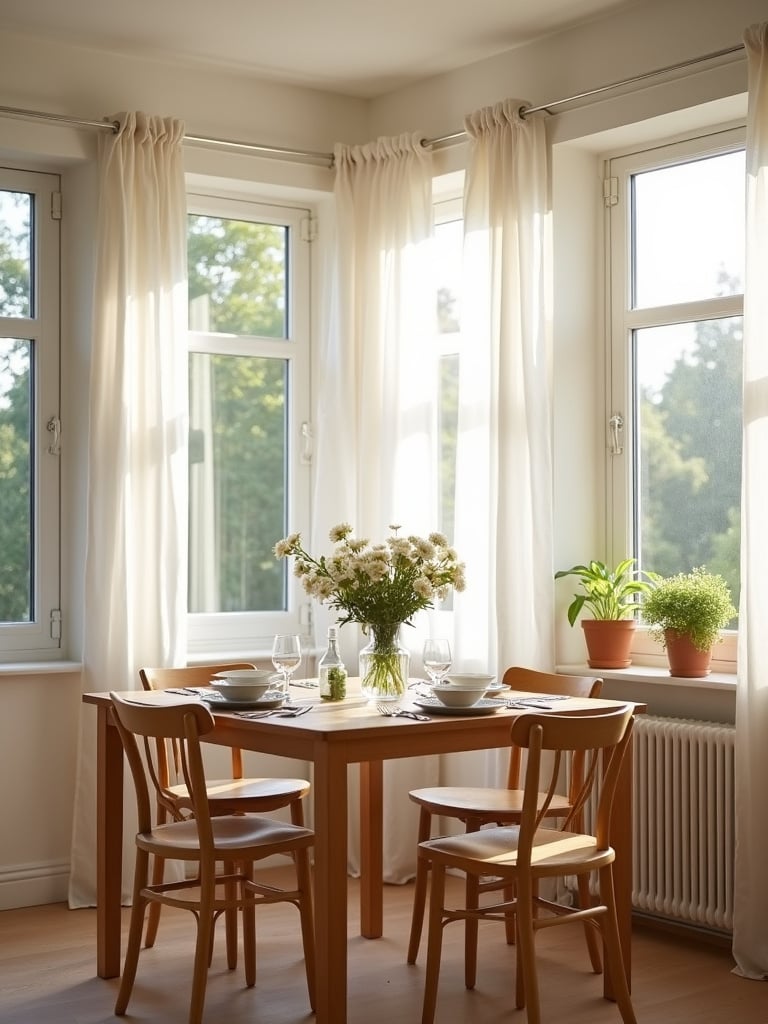
Don’t despair if your dining room lacks large windows or faces the wrong direction. There are clever design strategies to maximize what you have. Start by embracing light colors on your walls and ceilings. These act as reflectors, bouncing available light around the room. Mirrors are your secret weapon here – positioning a large mirror opposite a window can dramatically amplify natural light, making the room feel brighter and more spacious.
The size and shape of your dining table are paramount to creating a functional and comfortable space. Let’s look at how to get the scale just right.
It’s all about balance and flow. A dining table that’s too large will dominate the space, making it feel cramped and uncomfortable. Conversely, a table that’s too small can feel lost in a larger room, looking insignificant and failing to adequately serve your dining needs. Getting the scale right ensures comfortable seating, easy movement, and a visually harmonious space.
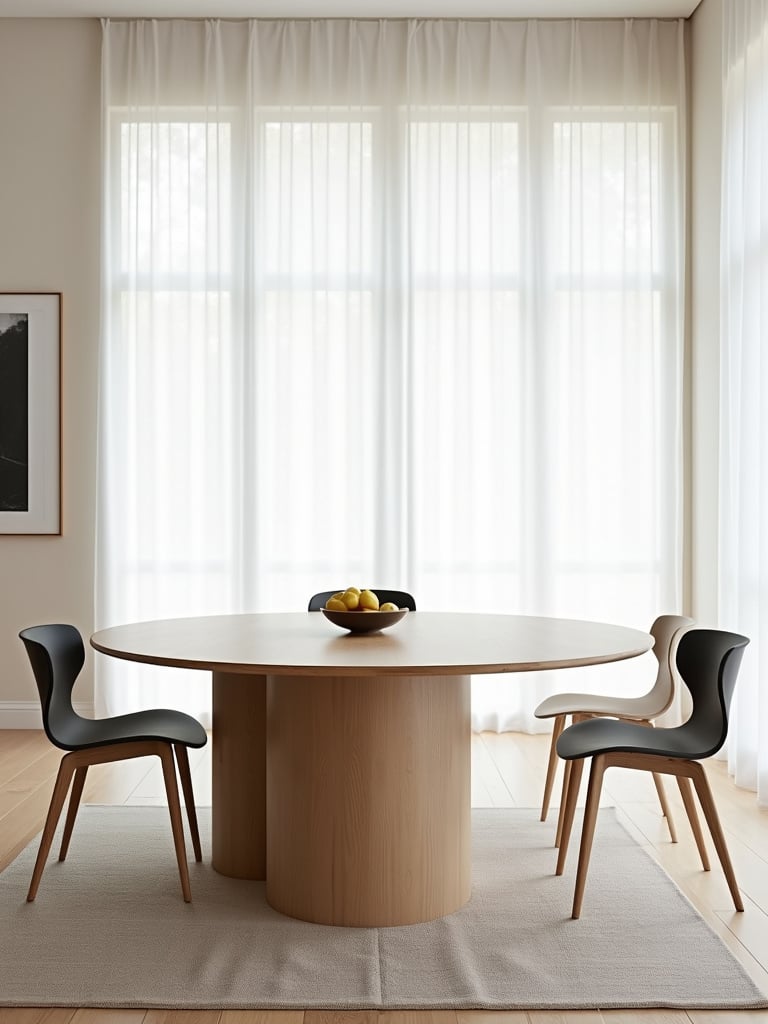
Before you start browsing tables, arm yourself with measurements. Measure your dining room’s length and width to define the boundaries you’re working within. You need at least 36 inches, ideally 42-48 inches, between the edge of the table and any walls or other furniture. This “buffer zone” allows chairs to be pulled out comfortably and people to move freely around the table. Factor in approximately 18-24 inches of width per chair, and don’t forget to consider room height if you’re dreaming of a statement chandelier.
“The perfect dining table isn’t just about looks—it’s about creating a space where people can gather comfortably and connect over meals.”
You and your guests will be spending significant time seated, so let’s move on to another element of dining comfort: the chairs.
Think about those long, leisurely dinners, filled with laughter and conversation. Comfortable dining chairs are the unsung heroes of these moments. They directly impact the entire dining experience. Uncomfortable chairs can be a major distraction, leading to fidgeting, shorter meals, and less enjoyable social interaction. Investing in comfortable chairs is an investment in enjoyable meals and a more welcoming dining room atmosphere.
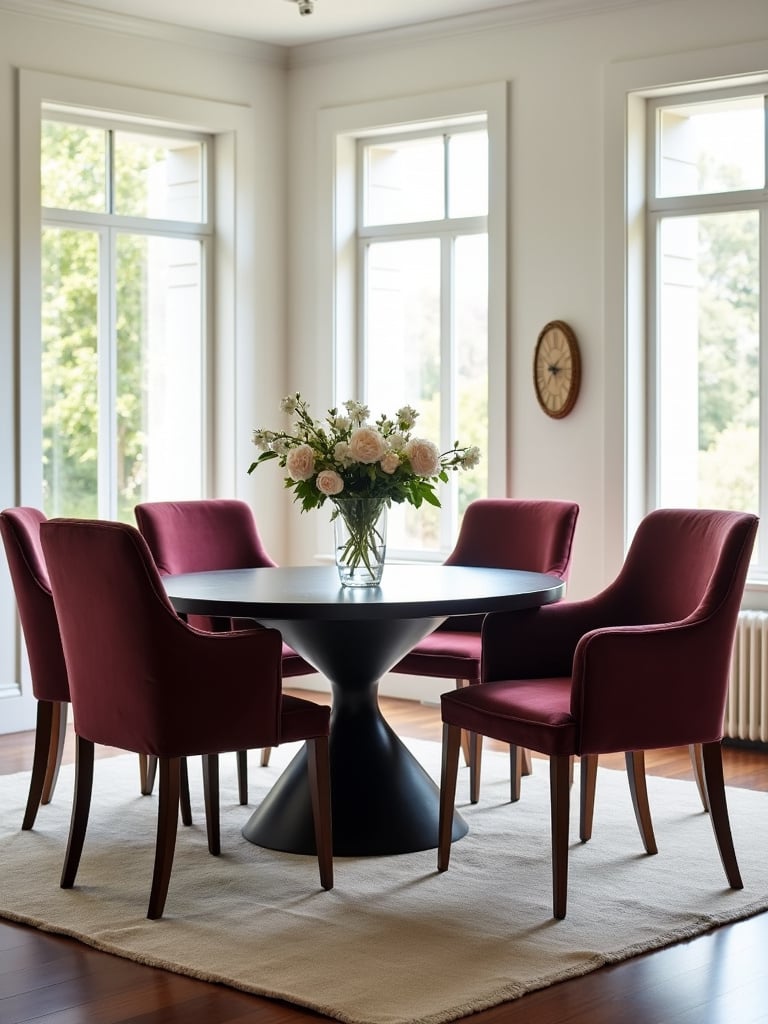
Several factors contribute to a dining chair’s comfort level. Seat height is key – ideally, your feet should rest flat on the floor with your knees at a 90-degree angle. Back support, particularly lumbar support, is essential for good posture during longer meals. Padding makes a huge difference, as does the upholstery material. Fabric, leather, or velvet each offer different textures and temperature regulation. A well-built, sturdy chair is fundamental for support and prevents wobbling or creaking.
Here’s the unexpected twist: a rug can add a layer of visual warmth and definition to your dining room design, anchoring the entire space.
A rug acts as a visual anchor, clearly delineating the dining space and separating it from adjacent areas. It’s like drawing an invisible line that says, “This is the dining zone.” This definition creates a sense of cohesion and intentionality, making the dining area feel more purposeful. Beyond aesthetics, rugs also offer practical benefits. They absorb sound, reducing echoes and creating a more pleasant acoustic environment, especially in rooms with hard flooring.
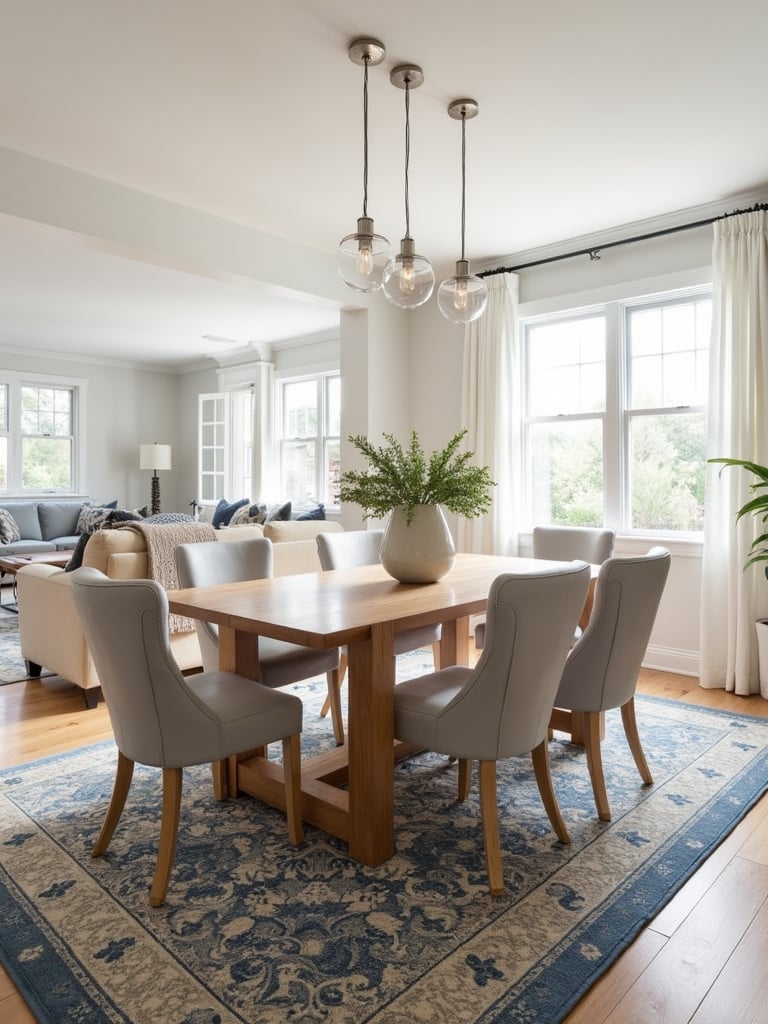
Choosing the right size rug is crucial for its defining power and functionality. The golden rule is to ensure the rug extends at least 24-30 inches beyond the edges of your dining table on all sides when chairs are pulled out. This prevents the frustrating experience of chair legs catching on the rug’s edge. To calculate the ideal rug size, measure your table and add 48-60 inches to both the length and width. However, also consider the overall room dimensions to find that visual sweet spot.
“A well-chosen rug doesn’t just sit under your dining table—it frames your entire dining experience and defines the conversation space.”
The heart of the matter is creating a dining space that’s versatile and inviting for any occasion. Layering lighting is key to achieving this flexibility.
Think about the different moods you want to create in your dining room. Bright and cheerful for breakfast? Warm and intimate for dinner? A single overhead light fixture simply can’t achieve this versatility. Layered lighting provides flexibility and control, allowing you to adjust the atmosphere to suit any occasion. A harsh overhead light can be unflattering and sterile, while layered lighting allows you to create depth, highlight features, and set the perfect mood.
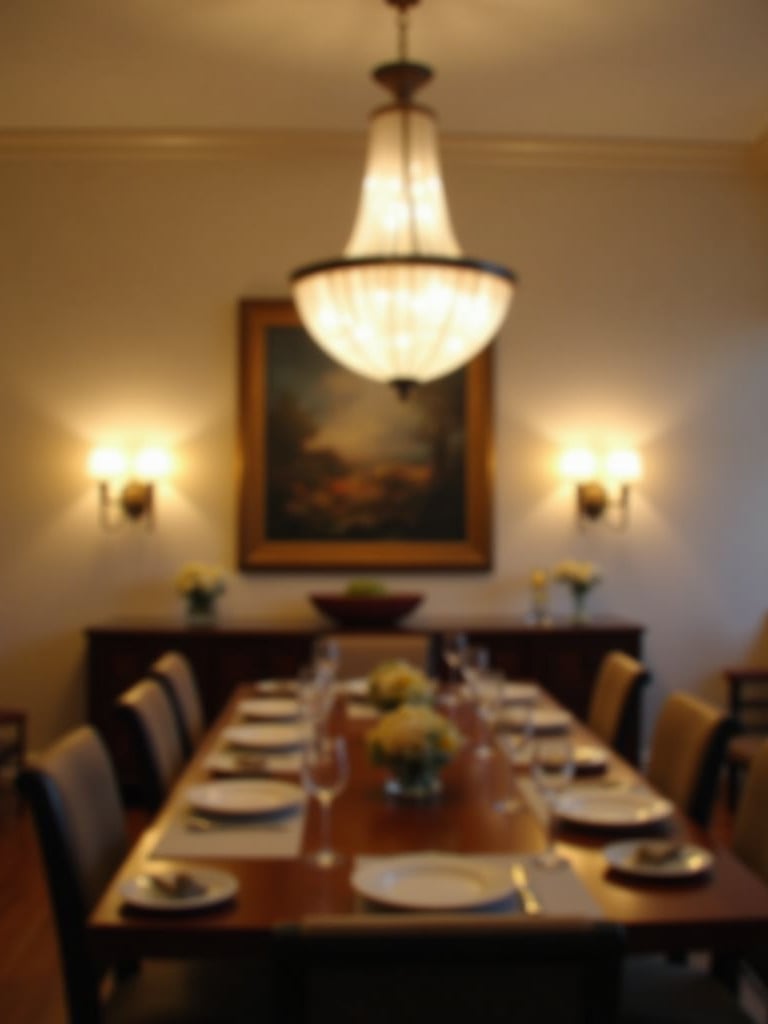
The magic of layered lighting comes from combining three main types. Ambient lighting provides overall illumination for the room—think chandeliers, recessed lighting, or pendant lights. This is your foundational layer. Task lighting is focused light directed at a specific area, like pendant lights directly above the dining table. Finally, accent lighting adds drama by highlighting specific objects or areas, such as spotlights on artwork or strip lighting within a china cabinet. By thoughtfully combining these layers, you create a dynamic and adaptable lighting scheme.
What complicates this is creating a focal point to draw the eye and give your dining room design a sense of purpose and style. A captivating focal point is essential for a well-designed space.
Imagine a room where your eyes wander aimlessly, unsure where to land. That’s what a dining room feels like without a focal point. A focal point anchors the space, instantly drawing the eye and creating a sense of visual order and balance. Without one, a dining room can feel bland, disorganized, and lacking in personality. It provides a central element around which the rest of the design can be built, defining the room’s style and atmosphere.
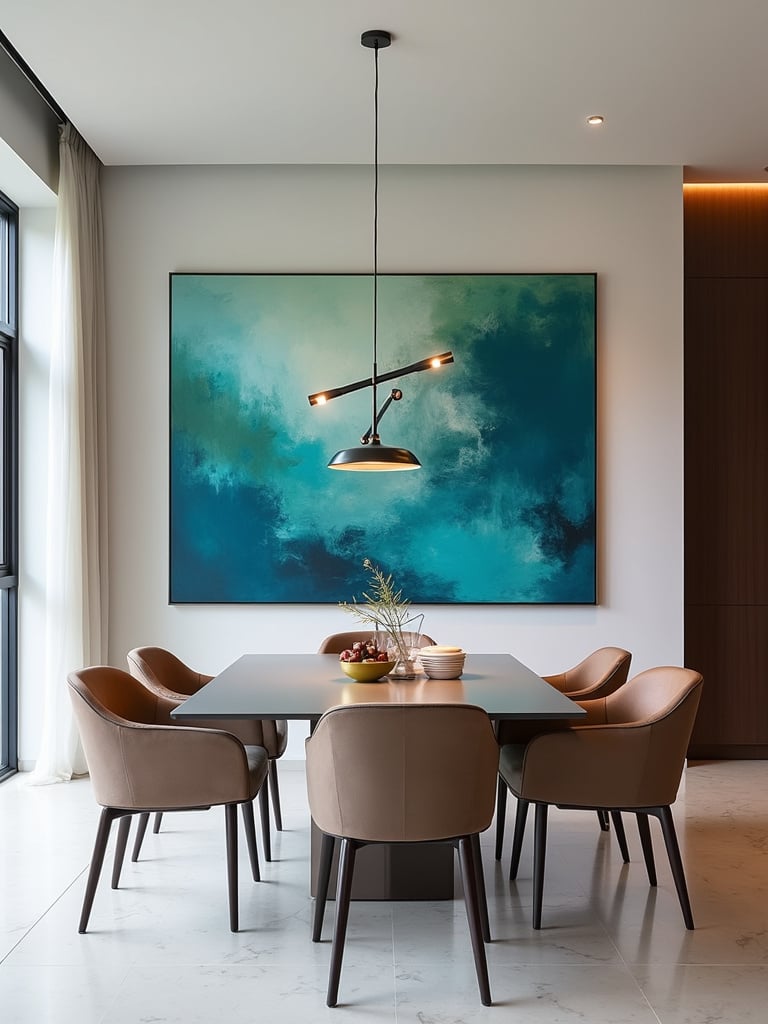
Common focal points include a statement chandelier, a large piece of artwork, or an impressive dining table. But to truly make your dining room unique, consider less conventional options. A dramatic accent wall with bold wallpaper instantly commands attention. A floor-to-ceiling window with breathtaking views naturally becomes a focal point. A large indoor plant brings the outdoors in and creates a striking visual. Even a curated gallery wall adds personality and visual storytelling. The best choice depends on your room’s existing features, size, style, and personal taste.
Let me paint you a picture of a dining room brought to life with plants and greenery. This simple addition creates a more vibrant and inviting atmosphere.
Plants do so much more than just look pretty. They bring a breath of fresh air, literally! Incorporating plants purifies the air, reducing toxins and increasing oxygen levels, creating a healthier and more inviting atmosphere. Studies show they reduce stress and boost mood, making mealtimes more enjoyable and relaxed. From a design perspective, plants inject texture, color, and visual interest, softening harsh lines and bringing a sense of tranquility to your dining room design.

The ideal plants depend on the amount of natural light your dining room receives and your plant care skills. For low-light conditions, Snake Plants, ZZ Plants, Peace Lilies, and Pothos are excellent choices, known for their resilience. If your dining room is bathed in sunlight, consider herbs like rosemary or basil in attractive pots, succulents, or even a small citrus tree for a Mediterranean vibe. Think about the size of your room and select plants that complement the space without overwhelming it.
The game-changer happened as I discovered another design trick to amplify both light and space: the strategic use of mirrors. Mirrors are powerful tools for transforming a dining room.
It’s visual magic! Mirrors work by reflecting the existing room, essentially doubling the perceived space. This is especially impactful in smaller dining rooms where maximizing space is paramount. The reflection visually pushes back the walls, making the room feel less confined and more open and airy. Strategic placement is key to maximizing this effect. Positioning a mirror to reflect a window or an open doorway can create a particularly dramatic and expansive illusion.

There’s a mirror style for every dining room aesthetic. Large statement mirrors, whether leaning casually against a wall or elegantly mounted, are a popular choice for creating a dramatic focal point. Gallery walls of smaller, decorative mirrors add visual interest and a touch of eclecticism, reflecting light from multiple angles. Mirrored furniture, such as a sideboard or buffet, subtly reflects light and adds a touch of glamour without being overwhelming. Consider your room’s overall style when choosing—a vintage or ornate mirror can perfectly complement a more traditional dining room design.
“A well-placed mirror doesn’t just reflect what’s in the room—it multiplies light, expands space, and adds a layer of visual intrigue to your dining area.”
Do you see how huge that is? Now let’s think about adding personal touches to the walls to truly make the dining room your own.
Think of your dining room walls as a blank canvas. Personalizing them transforms the space from purely functional to a reflection of your unique personality and style. It adds character, creates a welcoming atmosphere, and can even spark conversation. Art and decor evoke emotions, set the mood for meals, and elevate the overall dining experience. A personalized space feels more comfortable, more ‘you’, and ultimately, more inviting.

Start by considering the overall style of your dining room. Is it modern, traditional, rustic? Your art and decor should complement this style. Think about the color palette and choose pieces that harmonize with it. Wall size is crucial—a tiny piece of art on a large wall will look lost, while an oversized piece can overwhelm a small space. Consider the mood you want to create and the subject matter of the art. Food-related themes, landscapes, or abstract pieces can all work beautifully in a dining room design.
The missing piece is often simplicity and serenity. Decluttering is a powerful tool for creating an inviting dining space, allowing the beauty of your design elements to truly shine.
Imagine trying to relax and enjoy a meal in a space filled with visual chaos. Decluttering is essential because it eliminates visual noise, which can be distracting and stressful. A cluttered dining room can feel chaotic and unwelcoming, hindering relaxation and enjoyment during meals. Removing unnecessary items allows the eye to rest, creating a sense of calm and order. This promotes a more peaceful and inviting atmosphere, encouraging conversation and a generally more pleasant dining experience.
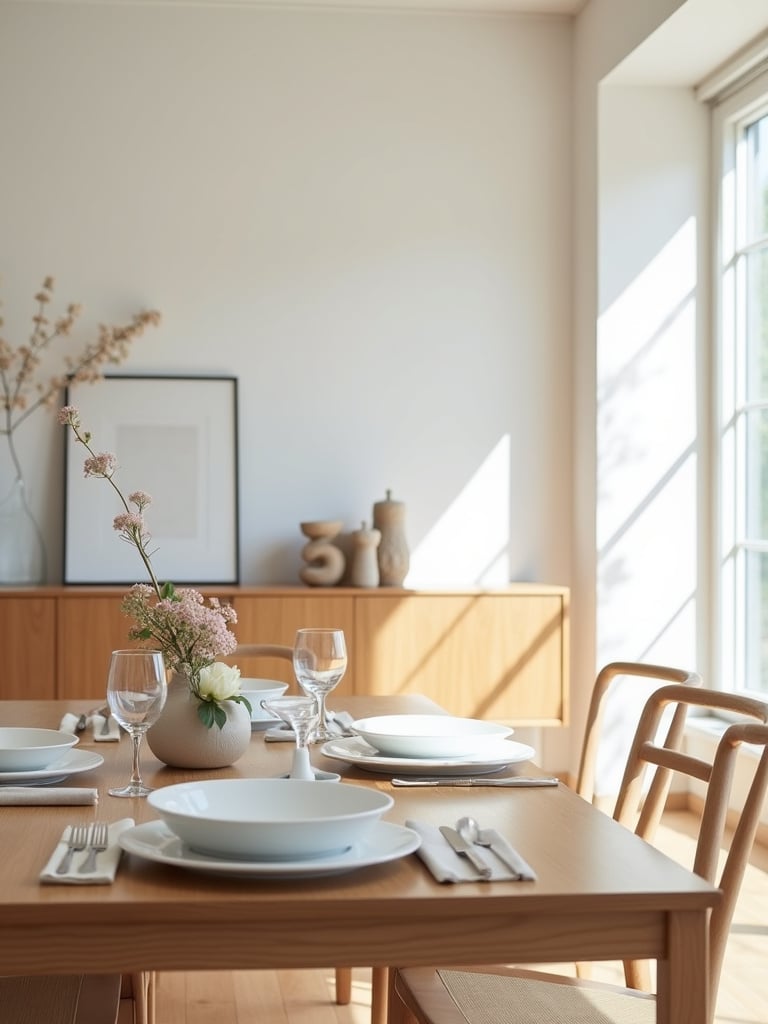
Dining rooms, despite their intended purpose, can easily become magnets for clutter. Common culprits include unused decorative items cluttering the table or sideboard, piles of mail or papers accumulating on surfaces, excessive dinnerware taking up valuable space, outdated linens lingering in drawers, and unnecessary furniture like extra chairs that are rarely used. Identifying these clutter hotspots is the first step to creating a more serene dining room design.
My breakthrough came when I realized that lighting can be both functional and decorative. A showstopper chandelier can instantly transform the entire dining room ambiance.
Think of a chandelier as the jewelry of your dining room. A statement chandelier instantly elevates the space, transforming it from a purely functional area into a focal point of elegance and style. It’s not just about illumination; it serves as both functional lighting and a piece of art, drawing the eye upwards and creating a sense of drama and sophistication. It can define the room’s aesthetic, tying together existing design elements or introducing a bold new direction in your dining room design.

Choosing the right statement chandelier involves careful consideration of several factors. First and foremost, consider the size and scale of your dining room. A chandelier that’s too small will get lost in a large space, while one that’s too large will overwhelm a smaller room. Ceiling height is also crucial—ensure there is sufficient clearance below the chandelier for comfortable movement. The chandelier should complement, not clash with, the room’s overall design. Consider the style, materials, finish, and the amount of light needed. And, of course, budget is a key consideration, as statement chandeliers can range from affordable to exceptionally expensive.
“The right chandelier doesn’t just light your dining table—it creates a statement that defines your entire dining experience.”
Things took an interesting turn when I explored a more relaxed and personality-driven approach to dining chairs. Embracing eclectic charm with mismatched chairs creates a truly unique dining space.
Mismatched dining chairs are a fantastic way to inject personality, visual interest, and a sense of curated style into your dining space. They break away from the formality of matching sets and prevent the room from feeling too stiff or predictable. Mixing and matching allows you to showcase your individual taste, create a more relaxed atmosphere, and add a touch of playful creativity to your dining room design. It’s also a brilliant way to incorporate chairs you already own or create a more budget-friendly dining set by sourcing individual chairs over time.
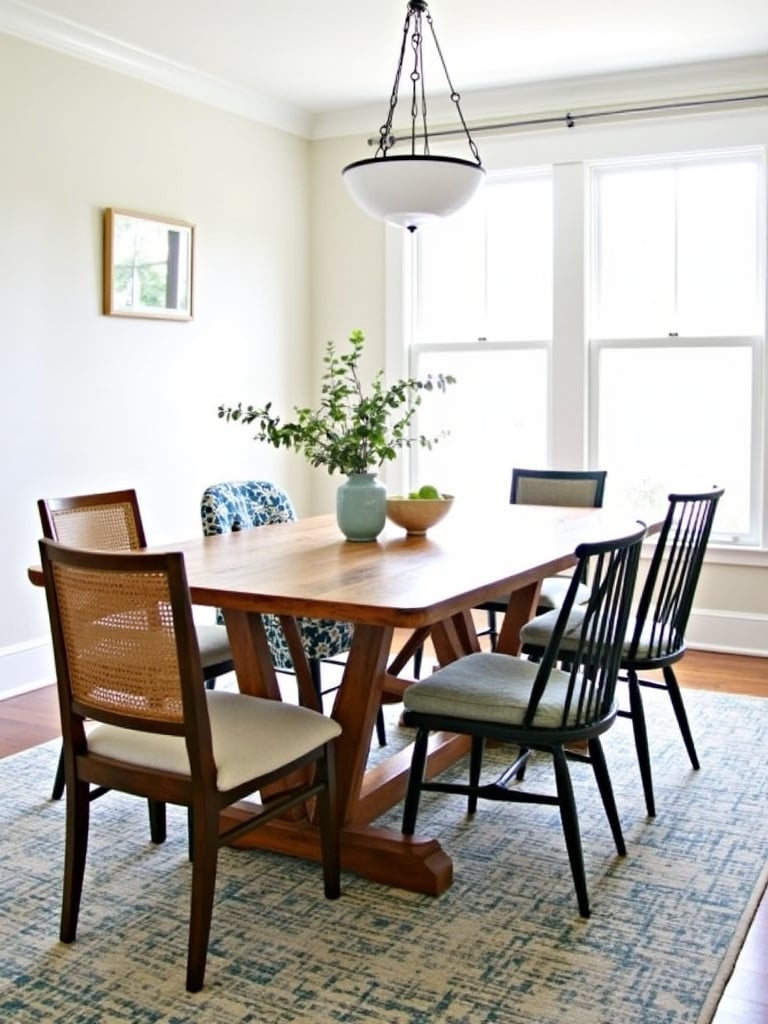
The key to successfully mixing and matching dining chairs is cohesion. While the chairs should be different, they need to share at least one common element to avoid looking chaotic. This unifying element could be a shared color palette, material, style, or even just chair height. Sticking to a range of blues and greens, for example, can tie together diverse chair styles. Even chair height or seat height can create a sense of visual harmony. Repeating these elements throughout the set creates a deliberate and stylishly mismatched look, rather than just a random collection of chairs.
It’s similar to how bench seating offers a unique blend of practicality and relaxed style. For smaller dining rooms especially, this option is worth considering.
Bench seating offers a multitude of advantages, particularly for modern living. It’s a fantastic space-saver, especially in smaller dining rooms or cozy breakfast nooks. Benches can be pushed completely under the table when not in use, maximizing floor space and making the room feel less cluttered. They provide seating flexibility, often accommodating more people than individual chairs, making them ideal for large families or frequent gatherings. Benches contribute to a more casual and inviting atmosphere, fostering a sense of togetherness during meals.
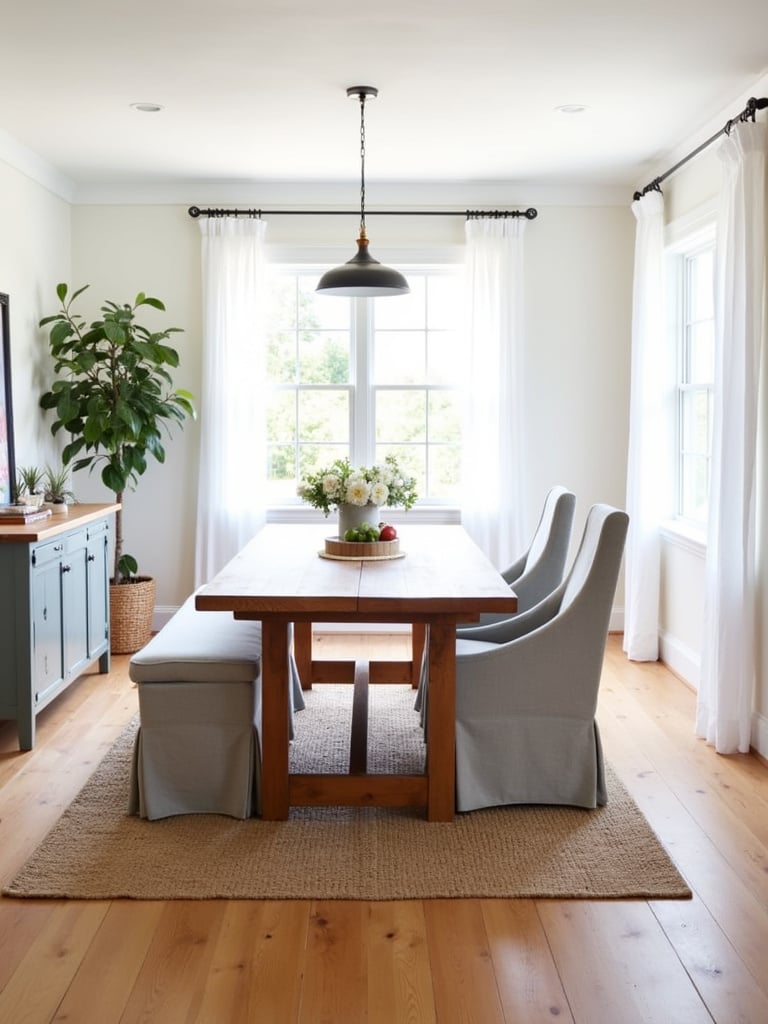
Dining benches are surprisingly versatile and come in a wide range of styles to complement any dining room aesthetic. You can find upholstered benches for added comfort and a touch of luxury, wooden benches for a rustic or farmhouse feel, backless benches for a minimalist look, benches with built-in storage for added functionality, and modern benches crafted from metal for a contemporary edge. Consider the overall style of your dining room design and choose a bench that harmonizes with it in terms of material, color, and shape.
The potential here is enormous, especially when you add a sideboard to your dining room. A sideboard is more than just furniture; it’s a dining room essential that blends storage and style.
Sideboards are truly the workhorses of the dining room, offering a wealth of benefits. Primarily, they provide invaluable storage for dinnerware, linens, serving pieces, and even bar essentials, helping to declutter your dining table and surrounding areas. Beyond storage, sideboards also serve as a stylish focal point, adding visual interest and personality to the room. The surface area is incredibly versatile—it can be used for serving food buffet-style, displaying decorative items, or even transforming into a temporary bar area for entertaining. A well-chosen sideboard elevates both the functionality and aesthetics of your dining room design.

Sideboards are available in a diverse array of styles to suit any taste and décor. Traditional sideboards feature ornate details and rich wood finishes. Modern sideboards showcase clean lines and often incorporate materials like glass or metal. Rustic sideboards emphasize natural materials like reclaimed wood and distressed finishes. Mid-Century Modern sideboards sport tapered legs and warm wood tones. To choose the right sideboard, consider the existing style of your dining room furniture, the size of the space, and your storage needs. Ensure the dimensions are proportional to the room and that it provides sufficient storage for your specific requirements.
My experience went like this: I discovered that beyond furniture and layout, texture is essential for adding depth and visual interest to a dining room.
Imagine a room filled with only smooth, flat surfaces. It might look clean, but it would likely feel sterile and uninviting. Texture is crucial for adding visual interest and depth, preventing a dining room from feeling flat and lacking in personality. Texture engages our senses beyond just sight, creating a more layered and dynamic environment. It adds richness and complexity, and can subtly influence the mood of the room, making it feel cozier, more sophisticated, or more rustic, depending on the textures you choose.
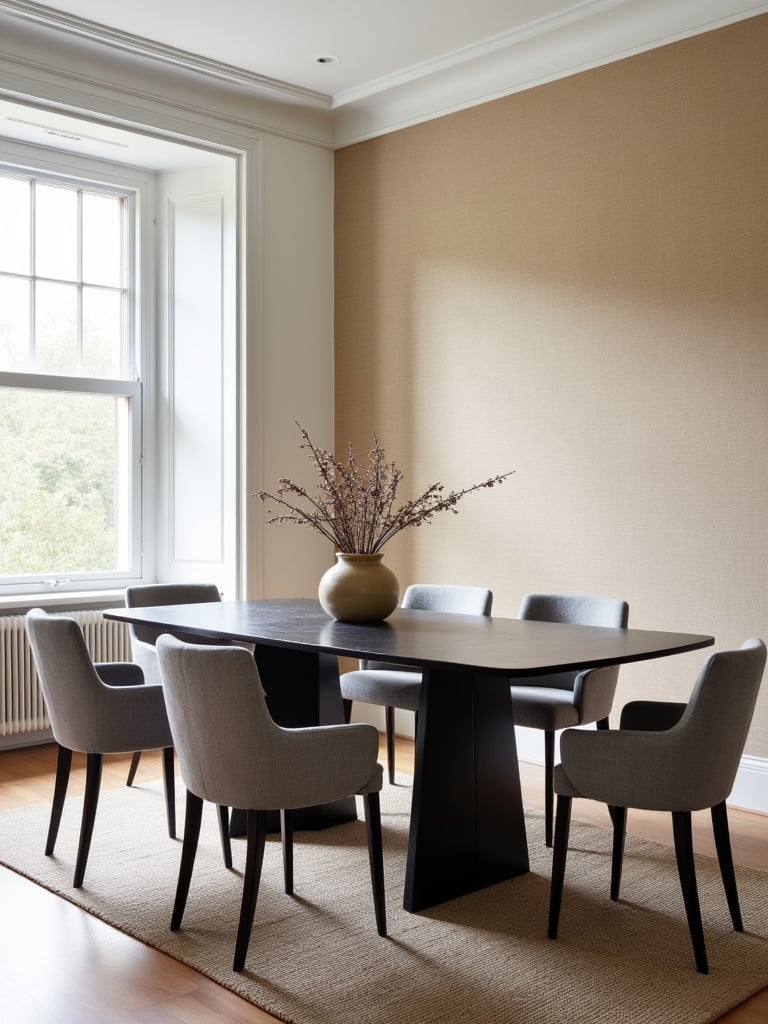
Texture can be introduced through a variety of design elements throughout your dining room. Walls are a prime canvas—consider textured paint, grasscloth wallpaper, wood paneling, exposed brick, or even a textured plaster finish. Furniture is another key area; upholstered chairs with woven fabrics, a rough-hewn wooden table, or a sideboard with carved details all contribute texture. Flooring plays a role too, with area rugs, textured tiles, or reclaimed wood adding tactile interest underfoot. Even accessories like linen tablecloths, woven placemats, ceramic vases, and metal sculptures enhance the tactile experience of your dining room design.
What really matters here is how color engages our emotions. Choosing the right color palette is fundamental to setting the perfect mood in your dining room.
Color is a powerful tool in dining room design, and its impact on our emotions and behaviors is well-documented. Warm colors like reds, oranges, and yellows are known to stimulate appetite and create a lively, energetic atmosphere, making them ideal for social gatherings and family meals. Cool colors like blues, greens, and purples tend to be more calming and relaxing, creating a more intimate atmosphere, perfect for quiet dinners. Neutral colors provide a versatile and sophisticated backdrop that can be accented with pops of color to achieve a desired mood and style.

Different color palettes evoke distinct moods in a dining room. A warm and inviting palette creates a cozy atmosphere, perfect for family gatherings. A sophisticated palette featuring grays, whites, and blacks, often accented with metallic touches, creates a refined ambiance. A calm and relaxing palette promotes tranquility, ideal for intimate dinners. A bold and energetic palette can inject personality, best suited for modern and eclectic dining room design. Finally, an earthy palette with greens, browns, and beiges creates a grounding and comforting atmosphere, perfect for a relaxed organic dining space.
The stumbling block is often in the details. Elevating your dining experience with beautiful tableware is a simple yet impactful way to enhance every meal.
Tableware is far more than just functional dishes. It plays a crucial role in setting the tone and ambiance for every meal, from casual breakfasts to formal dinners. Beautiful tableware elevates the entire dining experience by enhancing the visual appeal of the food, making it look more appetizing and inviting. It creates a sense of occasion, transforming even an ordinary meal into something special. Tableware also expresses personal style, reflecting your taste and attention to detail. The weight, texture, and design contribute to the overall sensory experience, subtly impacting how we perceive and enjoy our food.
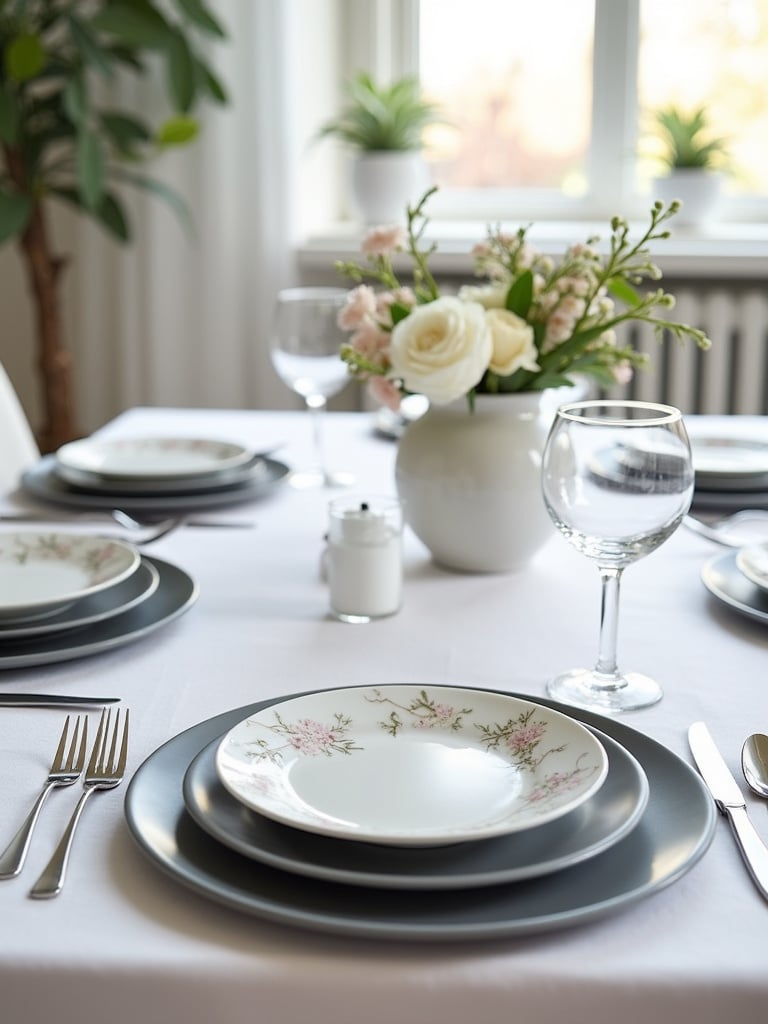
When selecting tableware, several key factors should be considered. Material is paramount—porcelain, stoneware, bone china, glass, and metal offer different aesthetics, durability levels, and price points. Style should complement your dining room design and personal taste. Durability is key, especially for frequent use. Functionality matters; select pieces that are appropriate for the types of meals you typically serve. Budget is always a factor, as tableware can range from affordable to very expensive. Finally, consider maintenance and whether you prioritize dishwasher-safe items and low-maintenance materials.
“Your tableware isn’t just about serving food—it’s about creating a complete sensory experience that enhances both the meal and your dining room design.”
It works similarly to how defining the dining zone brings structure and purpose to open-plan homes. Creating a distinct dining area is essential in these spacious layouts.
In increasingly popular open-plan layouts, the absence of physical walls can create a sense of vastness but also a lack of definition. Defining the dining area within an open-plan home is crucial to create a sense of purpose and intimacy within the larger space. Without definition, a dining table can feel like it’s just ‘floating’ in the middle of the room. A clearly defined zone provides a visual anchor, improves the overall flow of the open space, and can even contribute to better acoustics by subtly containing sound within the dining area.
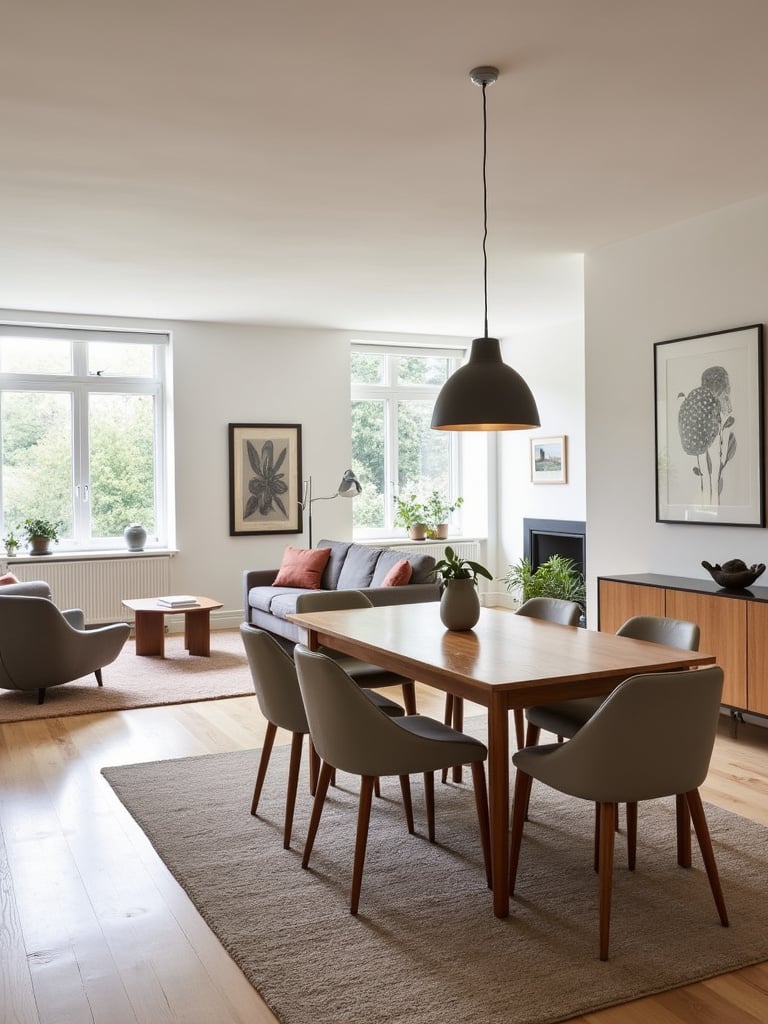
Defining a dining area in an open-plan layout presents several common challenges. Maintaining a cohesive design throughout the entire open space is essential, ensuring the dining area feels integrated rather than isolated. Providing adequate lighting specifically tailored for the dining area is crucial for creating the right ambiance. Managing noise levels can also be a challenge, especially if the dining area is adjacent to a busy kitchen or living room. The key is to strike a balance between openness and definition, creating a distinct dining zone that still feels connected to the overall open-plan design.
Let that sink in for a moment… Even the smallest details can make a big difference in your dining room design. The finishing flourishes are what truly complete the space and add that final layer of polish.
Think of small decor details as the punctuation marks in a sentence – they might seem minor, but they are essential for clarity and impact. In dining room design, these details are the unsung heroes. They add personality, texture, and visual interest, transforming a functional space into a welcoming and stylish environment. These seemingly small touches create a cohesive look, reflecting your personal style and making the dining room feel complete and intentional. They can elevate a simple design or tie together different elements, making it feel more polished and truly finished.

Choosing the right small decor details is all about thoughtful curation. Start by considering the overall style and color palette of your dining room. Your decor details should seamlessly complement these existing elements. Think about the scale of the room and the furniture—avoid overcrowding smaller spaces with too many items. Focus on quality over quantity, selecting a few key pieces that are well-made and visually appealing. Don’t be afraid to mix and match textures and materials to create depth. Most importantly, choose items that you genuinely love and that reflect your personal style. These small details should be a personal expression that brings you joy and enhances your dining experience.
Transforming your dining room into a space you truly love is within reach! From maximizing natural light and scaling your furniture correctly, to layering lighting and personalizing your walls, these 19 design ideas offer a comprehensive guide to creating a dining room that is both beautiful and functional.
Remember, it’s the thoughtful details, from comfortable chairs to carefully chosen tableware, that truly elevate the dining experience. Each element of your dining room design works together to create a cohesive, inviting space where memories are made.
So take these ideas, infuse them with your personal style, and watch as your dining room transforms into the heart of your home – a space where conversations flow, delicious meals are savored, and life’s special moments are celebrated in style and comfort.